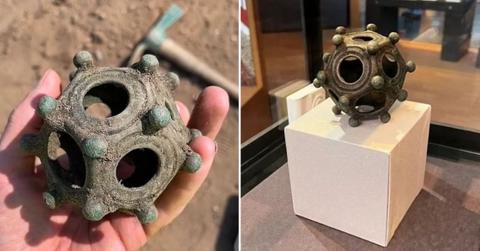Ancient Mystery: Archaeologists Stumped by Discovery of Nearly 2,000-Year-Old Twelve-Sided Roman Artifact

What could this 12-sided artifact be?
The ancient world holds captivating mysteries nestled in remote corners of the world, but the most recent mystery to perplex archaeologists recently emerged in the quaint English village of Norton Disney.
Unearthed thanks to the efforts of volunteers from the Norton Disney History and Archaeological Group last summer, the peculiar Roman artifact has stirred scholarly curiosity.
Dating back approximately 1,700 years, the object, crafted from copper, is a dodecahedron shape that boasts twelve sides, each with holes of varying sizes and small attached spheres. Th ancient artifact stands at a height of 3 inches and weighs almost nine ounces.
Featured in an episode of the BBC program Digging for Britain, Professor Alison Roberts remarked, "It has to be one of the greatest, most mysterious archaeological objects I've ever had the opportunity to look at up close."
Intriguingly, experts propose a possible origin dating back to the 1st Century AD, aligning with the earliest days of Roman presence in the region.
Despite its small size, the purpose of the bizarre find remains shrouded in uncertainty. Theories about its use range from the practical to the esoteric. The dodecahedron's construction, with its dozen identical sides, prompts speculation it may have been used for games of chance or gambling.
However, closer examination raises doubts about such theories, as Dr. Jonathan Foyle, an archaeologist from the University of Bath, contends. He suggests that the absence of numerical markings and the object's surprising fragility argue against its role in recreational pursuits.
- What Lies Beneath: NASA Scientist Believes Aliens May Have Found 'Perfect' Hiding Spot in Earth's Oceans
- Global Threat: Russia Insider Warns West of 'World War Using Nuclear Weapons' Amid Escalating Support for Ukraine
- Countdown to Disaster? Ex-NATO Official Warns Russia, Iran and China Could Wage WWIII in Just Years
Some believe the device had more practical uses, such as knitting. Contemporary artisans have experimented with plastic replicas, utilizing the dodecahedron's unique design to craft gloves with precision. Nonetheless, historical evidence of such practices among the Romans remains scarce.
Other theories range from measuring devices to astronomical instruments, but the true purpose of the dodecahedron remains elusive. Dr. Foyle suggests an intriguing possibility — that the object served as a tool for celestial observation, aiding in the framing of zodiac constellations.
Never miss a story — sign up for the Front Page Detectives newsletter. Be on the scene the moment news breaks.
This interpretation finds support in similar artifacts discovered elsewhere, including one found in Switzerland that features zodiacal inscriptions.
The dodecahedron is on public display at the Lincoln Museum through September.
Become a Front Page Detective
Sign up to receive breaking
Front Page Detectives
news and exclusive investigations.
